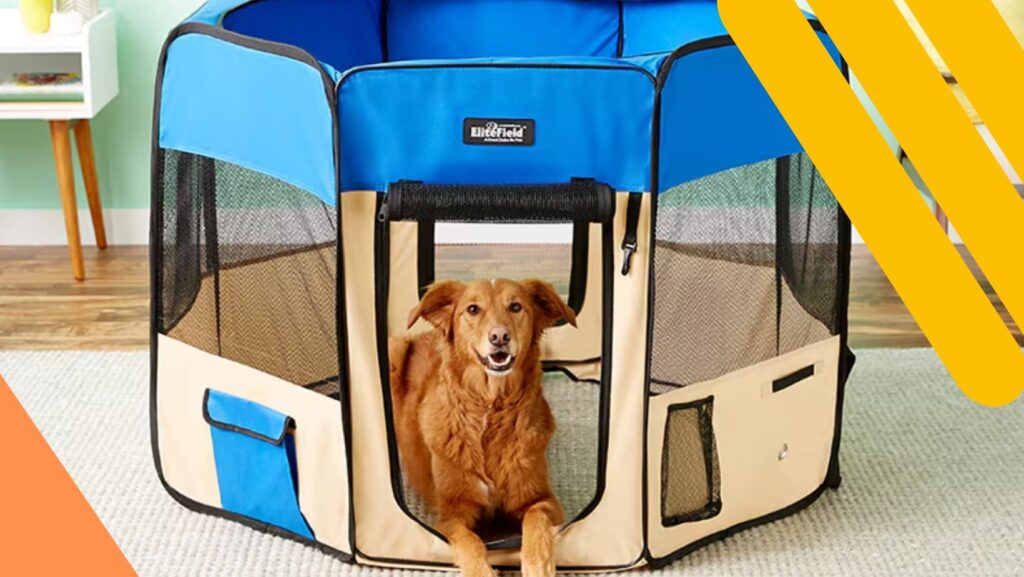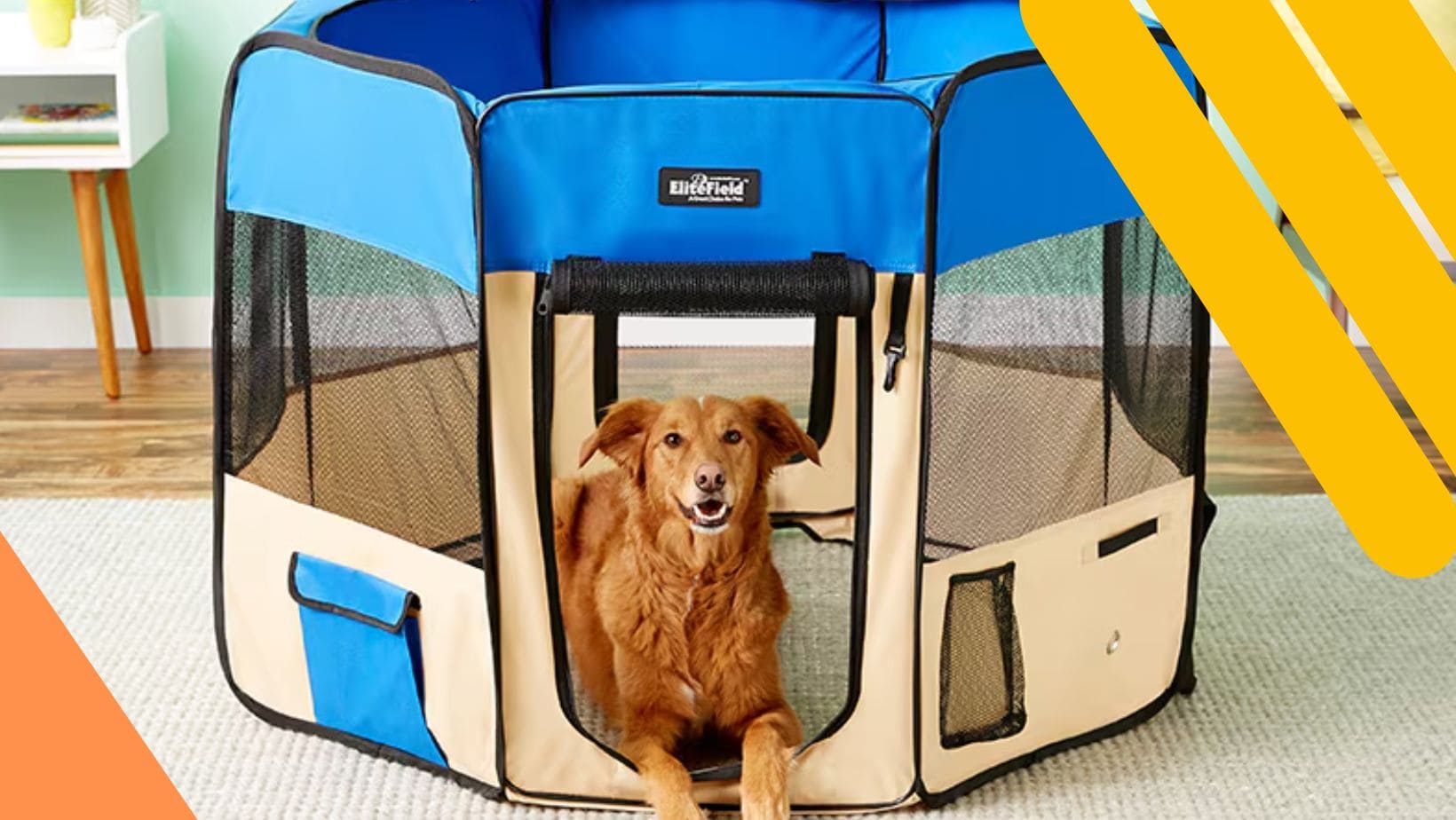As an Amazon Associate, I earn from qualifying purchases
Play Pen Vs Crate for Puppy: A playpen is an alternative to a crate for a puppy, offering a safe and confined space for play and relaxation. When choosing between a playpen or a crate for your puppy, there are several factors to consider.
A playpen provides more room for your puppy to move around and play, allowing them to expend energy and explore their surroundings. It also allows for the inclusion of toys, water, and a bed to make them comfortable. On the other hand, a crate can be beneficial for house training and providing a secure space for your puppy when you are unable to supervise them.
It could also help with travel and keeping your puppy safe in unfamiliar environments. We can say that the tax choice between a Play Pen and a Crate will completely depend on your preference.

Understanding A Play Pen
A playpen can be a valuable tool in puppy training. Understanding its features and benefits is essential for creating a safe and enjoyable environment for your furry friend.
Features
A playpen typically consists of panels that can be connected to create a secure enclosure for your puppy. It is portable and can be easily folded for storage or transport.
Benefits
- Safe Boundaries: Playpens provide a designated area for your puppy to play without the risk of wandering off or getting into dangerous situations.
- Training Support: You can use the playpen to assist in potty training, teaching boundaries, and creating a comfortable space for crate training.
- Comfort and Security: The playpen offers a cozy and secure space for your puppy to relax, nap, or play, promoting a sense of safety and comfort.
- Versatility: Playpens can also be used indoors or outdoors, making them a flexible option for various training and containment needs.
Understanding A Crate
A crate is a secure and cozy space for your puppy, providing them with a sense of security and a place to call their own. Understanding the benefits and features of using a crate for your puppy is crucial in their development and training.
Features
A crate typically comes with a sturdy construction, usually made of plastic, wire, or wood. It has a secure door for easy access and provides ventilation for the puppy. Some crates also come with a removable tray for easy cleaning.
Benefits
- Crate training helps in potty training, as dogs have an instinct not to soil their living area.
- It provides a safe and secure place for your puppy to retreat to when feeling overwhelmed or anxious.
- Crating can prevent destructive behavior when you are unable to supervise your puppy.
- It can be used as a travel tool for safe transportation of your puppy.
- Using a crate can aid in the establishment of a routine for your puppy.
Training Aspects
Training a puppy is an essential step in ensuring they grow up to be well-behaved and obedient dogs. Two popular options for training are the playpen and the crate.
Both methods have their advantages and drawbacks. In this article, we’ll explore the training aspects of both the playpen and the crate for your puppy.
House-training In A Play Pen
House training refers to teaching your puppy appropriate toileting habits. A playpen can provide a safe space for your puppy while allowing them to develop a sense of independence.
When using a playpen for house training, it’s most important to establish a designated potty area within the pen. Here are some key points to consider:
- Place a puppy pad or artificial grass in one corner of the playpen.
- Encourage your puppy to use that specific area for their bathroom needs.
- Praise and reward your puppy every time they use the designated area correctly.
- Consistency is key – make sure to take your puppy to the playpen at regular intervals to reinforce the desired behavior.
Crate Training Techniques
Crate training is another effective method for puppy training. When done correctly, it can provide a safe and comfortable den-like space for your puppy. Here are some crate training techniques you can use:
- Introduce your puppy to the crate gradually, allowing them to explore it at their own pace.
- Place soft bedding and toys inside the crate to make it a cozy and inviting space.
- Feed your puppy their meals inside the crate to create a positive association.
- Practice leaving your puppy in the crate for short periods, gradually increasing the duration.
- Never use the crate as a punishment – it should always be seen as a positive and safe space.
Remember, consistency, positive reinforcement, and patience are key when it comes to training your puppy in a crate or playpen. Regardless of the method you choose, always prioritize your puppy’s comfort and safety.
Long-term Use(Play Pen Vs Crate for Puppy)
Let’s take a closer look at the adaptability of a playpen and the transition to a crate, so you can make an informed decision for your furry friend.
Adaptability Of A Play Pen
A playpen offers a versatile and flexible option for managing your puppy’s movement and providing them with a safe space. The playpen can be easily adjusted to fit the size of your growing puppy, offering them ample room to play, relax, and explore.
With its open design, a playpen allows your puppy to have the freedom to move around and explore their surroundings. It can also be a great solution for housetraining, as it provides enough space for the puppy to have a designated area for sleeping, eating, and playing.
Moreover, a playpen could be a perfect choice for pet owners who want to create a safe and secure environment for their puppies when they are away.
Transition To A Crate
As your puppy grows and matures, they may benefit from transitioning to a crate for various reasons. While a playpen provides more space and freedom, a crate offers a cozy and den-like environment that can help promote a sense of security and relaxation for your puppy.
Transitioning your puppy from a playpen to a crate can be done gradually and judiciously, ensuring that they associate the crate with positive experiences. Start by placing their familiar bedding and toys inside the crate, and gradually introduce them to spending short periods inside.
Remember, the goal is to make the crate a safe and inviting space for your puppy, not a form of punishment. Crate training can be particularly helpful for managing destructive behavior, providing a safe space for naps, and assisting with housetraining efforts.
Size And Space Consideration
Both playpens and crates can be great options for containing your puppy, but it’s important to choose the right one based on your specific needs and the needs of your furry friend. In this section. We will delve into the size and space considerations for playpens versus crates, helping you make an informed decision for your beloved puppy.
Suitability For Different Breeds
Just like humans, puppies come in all shapes and sizes. This means that the size and space requirements for a playpen or crate can vary depending on the breed or mix of breeds of your puppy.
Larger breeds will need a more spacious option to ensure they have enough room to move around comfortably, while smaller breeds may feel more secure in a smaller confined environment. Space Constraints
Space constraints can heavily influence your decision between a playpen and a crate for your puppy. If you are living in a small apartment or have limited floor space, a crate may be the more suitable choice, as it offers a compact and secure space for your puppy.
On the other hand, if you have a larger living area or a dedicated space for your puppy to play and explore, a playpen can provide them with more freedom to move around and engage in play.
If you are unsure about the exact space your puppy will need, it is always a good idea to measure the available area and compare it to the dimensions of both playpens and crates. This will help you determine which option offers the best fit for your space constraints.
By considering the specific needs of your puppy’s breed and evaluating the available space in your home, you can choose the option that will provide your furry friend with a safe and comfortable environment to grow, play, and rest.
Safety Measures OfPlay Pen Vs Crate for Puppy
While a playpen provides more space for movement, a crate offers a secure environment for training and rest. Choosing between the two depends on the puppy’s needs and the owner’s preferences.
Escape-proofing The Play Pen
When setting up a playpen for your puppy, ensure securely anchored to prevent escape attempts.
Use heavy-duty fasteners to connect panels, making it escape-proof.
Check for any gaps or weak spots that your puppy could squeeze through or push open.
Ensuring Comfort In The Crate
Line the crate with a soft blanket or cushion to provide comfort for your puppy.
- Place favorite toys in the crate to make it a cozy space.
- Ensure the crate is properly sized, allowing your puppy to stand, turn around, and lie down comfortably.
- Introduce your puppy to the crate gradually to help associate it with positive experiences.
- Provide water and a chew toy to keep your puppy occupied and hydrated.
Cost Comparison
Initial Investment
- Play Pen: $50-$100
- Crate: $40-$80
Additional Expenses
| Play Pen | Create |
|---|---|
| Playpen cover: $20-$30 | Divider panel: $10-$20 |
| Replacement parts: Varies | Bedding/mat: $15-$25 |
Overall, choosing between a playpen and a crate for your puppy involves considering the initial investment and additional expenses.
Play Pen Vs Crate for Puppy
Final Verdict
After exploring the pros and cons of both playpens and crates for puppy training, it’s time to reach the final verdict. Deciding between these two options will largely depend on your puppy’s individual needs and your preferences.
Choosing The Ideal Space For Your Puppy
It’s most important to assess the specific requirements of your furry friend. Playpens can provide a spacious and secure area for your puppy to play, relax, and have their essentials within reach. However, crates offer a cozy and den-like environment that may assist in housetraining and ensuring safety, especially when you are unable to supervise your pet.
Both options come with their benefits, and you should take into account your puppy’s personality and behavioral patterns before making a decision.
As an Amazon Associate, I earn from qualifying purchases

